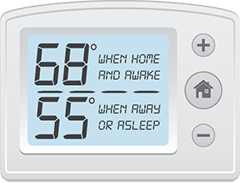
Winter heating
Heating bills rise when temperatures get colder in the winter. You not only use your heating system to keep your home warm, but you also use it to maintain a certain temperature when you’re away so that pipes don’t freeze and your home is comfortable when you return.
The greater the difference between the temperature outside and the thermostat setting inside a building, the harder the heating system will work and the more energy it will use, even if the thermostat isn’t set higher or the building is unoccupied for part of the day or night.
Sometimes it’s not easy to know how hard your heating system is working because it usually sits in a garage, and you get used to hearing it turn on so you stop noticing it.
If you set your heating to be at 68 degrees and the temperature outside is 30 degrees, your heating system is using more energy to maintain that 68 degrees than it would if the outside temperature was 40 degrees.
Dialing down helps you save
Because we heat our homes more in the winter, energy bills will be higher.
When the temperatures drop into the 30s, your heating system is working harder (using more energy) to keep your home heated even though the temperature setting of 68 degrees in the home hasn’t changed.
You can take control to keep your bills in check.

- Turn down your thermostat. We recommend 68° when you are home and awake and 55° when you are away or asleep.
- Check out our KPUB energy-efficient rebates for your home to help you save money and energy.
- If you are struggling to pay high winter bills, there is help out there. Click here to learn more about different organizations that help with bill payment assistance.
